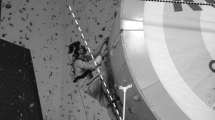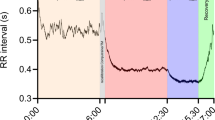Abstract
Numerous researchers have studied the physiological responses to seated and standing cycling, but actual field data are sparse. One open issue is the preferred cadence of trained cyclists while hill climbing. The purpose of this study, therefore, was to examine the affect of cycling position on economy and preferred cadence in trained cyclists while they climbed a moderate grade hill at various power outputs. Eight trained cyclists (25.8 ± 7.2 years, \(\ifmmode\expandafter\dot\else\expandafter\.\fi{V}{\text{O}}_{{2\,\max }}\) 68.8 ± 5.0 ml kg−1 min−1, peak power 407.6 ± 69.0 W) completed a seated and standing hill climb at approximately 50, 65 and 75% of peak power output (PPO) in the order shown, although cycling position was randomized, i.e., half the cyclists stood or remained seat on their first trial at each power output. Cyclists also performed a maximal trial unrestricted by position. Heart rate, power output, and cadence were measured continuously with a power tap; ventilation \(\ifmmode\expandafter\dot\else\expandafter\.\fi{V}{\text{e}}\), BF and cadence were significantly higher with seated climbing at all intensities; there were no other physiological differences between the climbing positions. These data support the premise that trained cyclists are equally economical using high or low cadences, but may face a limit to benefits gained with increasing cadence.
Similar content being viewed by others
References
Bertucci W, Duc S, Villerius V, Pernin JN, Grappe F (2005) Validity and reliability of the powertap mobile cycling powermeter when compared with the SRM device. Int J Sports Med 26(10):868–873
Borg G (1957) Simple rating methods for estimation of perceived exertion. In: Borg G (ed) Physical work and effort. Pergamon Press, New York, pp 39–46
Brooks GA, Fahey TD, White TP, Baldwin KM (2000) Cardiovascular dynamics during exercise. In: Exercise physiology: human bioenergetics and its applications. 3rd edn. Mountain View, Mayfield Press, pp 329–330
Chavarren J, Calbet JAL (1999) Cycling efficiency and pedaling frequency in road cyclists. Eur J Appl Physiol 80:555–563
Coast R, Welch HG (1985) Linear increase in optimal pedal rate with increased power output. Eur J Appl Physiol 53:339–342
Coyle EF, Sidossiss LS, Horowitz JF, Beltz JD (1992) Cycling efficiency is related to the percentage of Type I muscles fibers. Med Sci Sports Exerc 24(7):782–788
Foss O, Hallen J (2004) The most economical cadence increases with increasing workload. Eur J Appl Physiol 92:443–451
Hagberg JM, Mullin JP, Giese MD, Spitznagel E (1981) Effect of pedaling rate on submaximal exercise responses of competitive cyclists. J Appl Physiol 51(2):447–451
Harnish CR, Swensen TC, Pate RR (2001) Methods for estimating the maximal lactate steady state in trained cyclists. Med Sci Sports Exerc 33(6):1052–1055
Kenny GP, Reardon FD, Marion A, Thoden JS (1995) A comparative analysis of physiological responses at submaximal workloads during different laboratory simulations of field cycling. Eur J Appl Physiol Occup Physiol 71(5):409–415
Kohler G, Boutellier U (2005) The generalized force-velocity relationship explains why the preferred pedaling rate of cyclists exceeds the most efficient one. Eur J Appl Physiol 94(1–2):188–195
Kuipers H, Verstappen FTJ, Keizer HA, Guerten P (1985) Variability of aerobic performance in the laboratory and its physiologic correlates. Int J Sports Med 6:197–201
Lepers R, Hausswirth C, Maffiuletti N, Brisswalter J, van Hoecke J (2000) Evidence of neuromuscular fatigue after prolonged cycling exercise. Med Sci Sports Exerc 32(11):1880–1886
Lepers R, Millet GY, Maffiuletti NA, Hausswirth C, Brisswalter J (2001) Effect of pedalling rates on physiological response during endurance cycling. Eur J Appl Physiol 85(3–4):392–395
Lucia A, Hoyos J, Chicharro JL (2001) Preferred pedaling cadence in professional cycling. Med Sci Sports Exerc 33(8):1361–1366
Lucia A, San Juan AF, Montilla M, CaNete S, Santalla A, Earnest C, Perez M (2004) In professional road cyclists, low pedaling cadences are less efficient. Med Sci Sports Exerc 36(6):1048–1054
MacIntosh BR, Neptune RR, Horton JF (2000) Cadence, power, and muscle activation in cycle geometry. Med Sci Sports Exerc 32(7):1281–1287
Marsh AP, Martin PE (1993) The association between cycling experience and preferred and most economical cadences. Med Sci Sports Exerc 25(11):1269–1274
Marsh AP, Martin PE (1997) Effect of cycling experience, aerobic power, and power output on preferred and most economical cadences. Med Sci Sports Exerc 29(9):1225–1232
Marsh AP, Martin PE (1998) Perceived exertion and the preferred cycling cadence. Med Sci Sports Exerc 30(6):942–948
Marsh AP, Martin PE (2000) Effect of cadence, cycling experience, and aerobic power on delta efficiency during cycling. Med Sci Sports Exerc 32(9):1630–1634
Miller TA, Wells CL, Martin PE (1988) The effect of position and cadence on the cardiovascular response of up-hill cyclists. Med Sci Sports Exerc 20(2):S64
Millet GP, Tronche C, Fuster N, Candau R (2002) Level ground and uphill cycling efficiency in seated and standing positions. Med Sci Sports Exerc 34(10):1645–1652
Mognoni P, di Prampero PE (2003) Gear, inertial work and road slopes as determinants of biomechanics in cycling. Eur J Appl Physiol 90(3–4):372–376
Nielsen JS, Hansen EA, Sjogaard G (2004) Pedalling rate affects endurance performance during high-intensity cycling. Eur J Appl Physiol 92(1–2):114–120
Ryschon TW, Stray-Gundersen J (1991) The effect of body position on the energy cost of cycling. Med Sci Sports Exerc 23(8):949–953
Samozino P, Nicolas H, Frederique H (2006) Interactions between cadence and power output effects on mechanical efficiency during sub maximal cycling exercises. Eur J Appl Physiol 1:1–7
Signorile J, Holdern S, Coast JR (1990) The feasibility of the windload simulator as an alternative to on-road training. J Appl Sport Sci Res 4(1):5–8
Swain DP, Wilocox JP (1992) Effect of cadence on the economy of uphill cycling. Med Sci Sports Exerc 24(10):1123–1127
Swensen TC, Harnish CR, Beitman L, Keller BA (1999) Noninvasive estimation of the maximal lactate steady state in trained cyclists. Med Sci Sports Exerc 31(5):742–746
Takaishi T, Yamamoto T, Ono T, Ito T, Moritani T (1998) Neuromuscular, metabolic and kinetic adaptations for skilled pedaling performance in cyclists. Med Sci Sports Exerc 30(3):442–449
Tanaka H, Bassett DR Jr, Best SK, Baker KR (1996) Seated versus standing cycling in competitive road cyclists: uphill climbing and maximal oxygen uptake. Can J Appl Physiol 21(2):149–154
Vercruyssen F, Hausswirth C, Smith D, Brisswalter J (2001) Effect of exercise duration on optimal pedaling rate choice in triathletes. Can J Appl Physiol 26(1):44–54
Watson G, Swensen T (2006) Effects of altering pedal cadence on cycling time-trial performance. Int J Sports Med 27(4):296–300
Acknowledgments
We wish to thank Chad Butts, Kelly Brady and Janet Wigglesworth, Ph.D. for their help with this study. We would also like to thank Dr. Pietro di Prampero for his help in preparing our efficiency data.
Author information
Authors and Affiliations
Corresponding author
Rights and permissions
About this article
Cite this article
Harnish, C., King, D. & Swensen, T. Effect of cycling position on oxygen uptake and preferred cadence in trained cyclists during hill climbing at various power outputs. Eur J Appl Physiol 99, 387–391 (2007). https://doi.org/10.1007/s00421-006-0358-7
Accepted:
Published:
Issue Date:
DOI: https://doi.org/10.1007/s00421-006-0358-7




